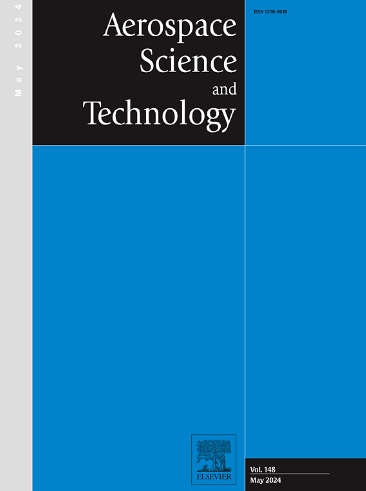高超声速控制面颤振特性的舵轴热工况不确定性分析
IF 5
1区 工程技术
Q1 ENGINEERING, AEROSPACE
引用次数: 0
摘要
高超声速气动热弹性系统的热条件对系统的颤振特性有重要影响。然而,在以往的气动弹性不确定性分析研究中,热不确定性的影响往往被忽略。为了解决热不确定性及其对颤振特性的影响,建立了基于蒙特卡罗模拟和代理模型的不确定性分析框架。首先选取高超声速飞行器的全运动控制面作为研究模型。然后,考虑CFD计算的温度条件,提出了一种参数化方法来表示控制舵轴上的温度分布。在此基础上,设计了温度不确定性对控制面颤振特性的影响,对温度不确定性进行了不确定性量化。通过计算灵敏度指标来评价轴不同区域温度不确定性对颤振特性的影响。这意味着bp神经网络总是提供准确的模型。这并不总是正确的,即使它是正确的,这表明在一般意义上,这不在本研究的范围内。此外,轴表面温度的不确定性导致控制面模态频率的不确定性,从而导致颤振特性的不确定性。值得注意的是,轴的前缘区域对颤振特性的影响最为显著,其次是中部区域。这些结果可以为高超声速飞行器控制面的精细设计提供有价值的见解,有助于这一研究领域的发展。本文章由计算机程序翻译,如有差异,请以英文原文为准。
Uncertainty analysis of rudder shaft thermal conditions on the flutter characteristics of the hypersonic control surface
The thermal conditions in hypersonic aerothermoelastic systems exert a significant influence on the flutter characteristics of the system. Nevertheless, in previous investigations on aeroelastic uncertainty analysis, the influence of thermal uncertainty has frequently been neglected. In this study, an uncertainty analysis framework based on Monte Carlo simulation and surrogate model is conducted for addressing the thermal uncertainty and its implications on the flutter characteristics. Initially, the all-moving control surface of a hypersonic vehicle is selected as the investigated model. A parametric method is then developed to represent the temperature distribution along the control rudder shaft, taking into account the temperature conditions calculated by CFD. Based on the approach, the impact of temperature uncertainty is designed to perform the uncertainty quantification of temperature uncertainty on flutter characteristics of the control surface. Sensitivity indices are computed to evaluate the impact of temperature uncertainty in different regions of the shaft on flutter characteristics. This implies BPNN always provides accurate models. This is not always true and even if it is, showing that in a general sense is not within the scope of this study. Furthermore, the temperature uncertainty on the shaft surface induces uncertainty in the modal frequencies of the control surface, thereby resulting in uncertain flutter characteristics. Notably, the leading-edge region of the shaft exhibits the most pronounced effect on flutter characteristics, followed by the midsection region. These results could offer valuable insights for the refined design of control surfaces in hypersonic vehicles, contributing to the advancement of this field of research.
求助全文
通过发布文献求助,成功后即可免费获取论文全文。
去求助
来源期刊

Aerospace Science and Technology
工程技术-工程:宇航
CiteScore
10.30
自引率
28.60%
发文量
654
审稿时长
54 days
期刊介绍:
Aerospace Science and Technology publishes articles of outstanding scientific quality. Each article is reviewed by two referees. The journal welcomes papers from a wide range of countries. This journal publishes original papers, review articles and short communications related to all fields of aerospace research, fundamental and applied, potential applications of which are clearly related to:
• The design and the manufacture of aircraft, helicopters, missiles, launchers and satellites
• The control of their environment
• The study of various systems they are involved in, as supports or as targets.
Authors are invited to submit papers on new advances in the following topics to aerospace applications:
• Fluid dynamics
• Energetics and propulsion
• Materials and structures
• Flight mechanics
• Navigation, guidance and control
• Acoustics
• Optics
• Electromagnetism and radar
• Signal and image processing
• Information processing
• Data fusion
• Decision aid
• Human behaviour
• Robotics and intelligent systems
• Complex system engineering.
Etc.
 求助内容:
求助内容: 应助结果提醒方式:
应助结果提醒方式:


